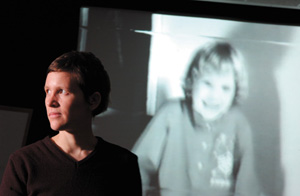 Investigations
Investigations
Muse and medium
What Helen Mirra calls her
“complicated relationship to authorship” began
in her childhood, when as the sole member of the “Steamer
Club” she awoke many mornings to discover the latest
chapter of a serial adventure story slipped under her bedroom
door. “The Adventures of Helen and the Monster Baby”
and other tales, tapped out on a manual typewriter by Mirra’s
father, were illustrated with pop-culture images, such as
the roughly cut-out monkey from The Planet of the Apes
pasted onto chapter five of “Monster Baby.”
The stories’ protagonist, who happened also to be
named Helen, was a brave little girl who saved frightened
babies and helpless animals from harm.
 Photo by Dan
Dry
Photo by Dan
Dry |
| In Helen Mirra’s
1998 Untitled Song (heh), constructed from
childhood home films, authorship is up for grabs. |
“In reading the material as an
adult I understood that my father was the person who behaved
the way I did in the stories, and I was really the monster
baby,” the senior lecturer in the Committees on the
Visual Arts and Cinema and Media Studies commented at a
retrospective screening of her video collages and films.
This transference between her father and herself, she explained,
showed her that authorship can be fluid. And film and video,
she discovered, offered a rich context in which to explore
the complicated relationship between identity and authorship.
With I, Bear (1994), made while
working on an M.F.A. at the University of Illinois at Chicago,
she returned to those childhood adventure stories, cutting
and pasting together a script from the tales, which she
had recorded her father reading aloud. That became a soundtrack
for the video, constructed from vintage footage of herself
as a child having a conversation with her stuffed bear,
intercut by a nature film of a real bear. Spliced into her
father’s halting reading—“‘Who are
you?’ asked Helen. ‘I am Helen. I am Helen’”—are
the sounds of birdsong, growls, and a tumbling stream.
Since completing her degree in 1996 the
32-year-old Mirra has consistently caught attention. In
2002 she participated in seven group shows (from San Francisco
to Vienna), had three solo exhibitions (including one at
New York’s Whitney Museum of American Art), and received
a fellowship to work in artists’ studios at Bleckede
Castle in Lower Saxony.
Along the way she has built a reputation
as a “post-cinema artist,” Yuri Tsivian, professor
of art history and cinema and media studies, explained at
the event. In other words, for Mirra film is both muse and
medium. In Becket (1996) it’s muse: she made a “silent
silent film” by cutting 16-mm-wide blue cotton banding
into rectangular “frames” and sewing them back
together to resemble a strip of film, unrolled and installed
as a horizontal line on a gallery wall. In the 1996 Schlafbau
(Sleep) film resumes its place as medium: a black-and-white
aerial shot of water takes up the top three-quarters of
the screen, while beneath it run scenes from the bottom
quarter of six foreign films—necks, feet, knees, and
other borders—complete with subtitles.
Cutting and splicing—the labor
of both filmmaking and collage (and sewing, for that matter)—are,
Mirra explained, what make her art meaningful to her. Her
notions of labor and travel also underlie the water images
that appear and reappear in her film. Living in San Francisco
in the early 1990s, she began thinking about the life of
the sailor, who went to sea not for the romantic “pull
of the water,” she said, but out of necessity: the
“push of the land” to find work.
The “confluence of labor and the
restfulness of water” became the subject of Third
(1998). In that video Mirra takes 30 seconds of the 1934
French film L’Atalante and repeats the same
few scenes over and over for 45 minutes. While the original
film concerns a pair of newlyweds floating downriver on
a barge, Mirra’s version focuses on brief appearances
by the cabin boy, a character so secondary as to be “tertiary”
(hence the film’s title).
The nature of film as a series of sections
has led Mirra to contemplate the medium as a sort of map.
In A Map of 81°N, at a Scale of One Degree to One
Foot, for example, she hand-watercolored a blank 360-foot-long
strip of 16-mm film with dark blue, light blue, white, and
brown in a direct, foot-per-degree correspondence with the
presence of water, ice, snow, and land along that tundra
latitude. When screened, the film evokes the same flying
sensation that the shots of water in Schlafbau
and Third do, the scenery rushing by below but
essentially remaining unchanged. Yet, for the viewer,
81°N also has a tactility that in feature films
would be considered flawed, with flakes of watercolor and
strands of lint catching for brief moments before disintegrating
under the force of the spinning reel and heat of the projector
light.
Indeed, the appearance and disappearance
of the flakes and lint as the painted scenery goes by form
81°N’s only plot—an odd outcome that
is not lost on Mirra. “I’m interested in plot
only as a bystander,” she commented, rather than as
the driving force of her films. By pulling from other sources
for many of her works, her role as author is to be a bystander
too.
—S.A.S.



![]() Advertising
Advertising
![]() About
the Magazine
About
the Magazine ![]() Alumni
Alumni
![]() UChicago
UChicago
![]()
![]() ©2003 The University
of Chicago® Magazine
©2003 The University
of Chicago® Magazine ![]() 5801 South Ellis Ave., Chicago, IL 60637
5801 South Ellis Ave., Chicago, IL 60637![]() fax: 773/702-0495
fax: 773/702-0495 ![]() uchicago-magazine@uchicago.edu
uchicago-magazine@uchicago.edu